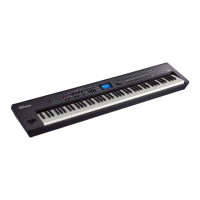Detailed Tone Settings (Designer)
Type Explanation
3
E.PIANO
Tremolo types of diering character are available, allowing
you to reproduce the character of classic electric pianos when
combined with an electric piano sound.
Characteristics of the tremolo types
OLDCASE MONO
Used in conjunction with TINE EP, this simulates an early
model of a classic electric piano of the 60s.
OLDCASE STEREO
Used in conjunction with TINE EP, this simulates a classic
electric piano sound of the early 70s.
NEWCASE
Used in conjunction with TINE EP, this simulates a classic
electric piano sound of the late 70s and early 80s.
DYNO
This model allows you to vary the shape of the tremolo
waveform.
Used in conjunction with TINE EP, this simulates an electric
piano sound used in many recordings of the early 80s.
WURLY
Used in conjunction with REED E.PIANO, this simulates a
classic electric piano sound of the 60s.
4
GUITAR AMP
Simulates playing through a guitar amp.
MEMO
Since the [DRIVE] knob faithfully simulates the
volume knob of a guitar amp, turning the knob
toward the left will also decrease the volume.
5
ROTARY This simulates a rotary eect suitable for organ sounds.
MEMO
For details, refer to “Eect Parameter Guide” (PDF).
For details on how to obtain the PDF, refer to “Obtaining PDF
Manuals” on the front cover.
Simulating the Creation of Organ
Tones
These settings are available only if a TW-Organ (tonewheel organ)
tone is selected.
On a tonewheel organ, you can create original sounds by sliding
nine harmonic bars (drawbars) forward or backward to change their
relative balance. Each bar is assigned a dierent footage, and this
footage determines the pitch of the sound. 8’ is the footage that
forms the basic pitch of the sound; this is the center around which
you create the tone.
For details, refer to “Creating the Organ Tones” (p. 22).
36

